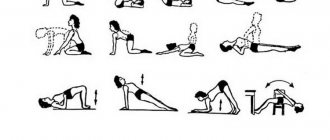Features of the classes
The specificity of yoga during menstruation lies only in the correct selection of poses. Necessary:
- exclude complex elements;
- do not set high standards so as not to overstrain the body;
- Avoid sudden movements and tension in the abdominal area, so as not to intensify menstrual pain.
Yoga sessions should be aimed at relaxing and restoring the body.
It is necessary to give preference to those exercises that are aimed at strengthening:
- back muscles;
- breasts;
- hands;
- legs
Otherwise, yoga classes do not change. With proper training, yoga will not only not cause harm, but will also be very useful.
Reporting period (yoga during menstruation)
Yoga Journal, No. 14, July/August 2007, https://www.yoga-journal.ru/ During menstruation, you should practice according to a special program. How and why - says Elena Ulmasbaeva.
When we talk about menstruation, we usually lower our voices. And this is quite understandable - after all, the topic is quite intimate. These days are called “critical”. However, in fact, nothing critical happens during this period: menstruation indicates that the woman is of childbearing age. By the way, with menstrual flow, many toxins are removed from the body, and women live longer for this reason.
Today it is generally accepted that menstruation should not affect everyday life: it is enough to use a tampon to continue playing sports, riding a bike, carrying heavy bags, working actively, doing repairs - whatever.
However, in Eastern culture, in particular Indian, a different view prevails. During menstruation, a woman loses energy, gets rid of toxins and even comes into contact with the other world. During this period, she does not perform rituals, is not allowed to prepare ritual dishes, and does not go to the temple or cemetery. In everyday life, a woman is instructed to speak quietly, not make sudden or active movements, and perceive these few days as a period of cleansing and peace.
the Forbidden fruit
During menstruation, yoga practice should also be adjusted. I recommend that everyone follow a special program, even if you don’t feel any changes in your health at all. The set of asanas can be different, depending on the level of practice, age and health status.
Beginners are sometimes surprised by this approach - after all, in a fitness club there are no restrictions when it comes to shaping. The thing is that asanas have a much deeper effect on the physiology and functioning of internal organs than simple physical exercises. That is why some poses are prohibited (for example, inverted ones), while others are performed in various variations.
The ban on inverted asanas is due to the physiology of women. The fact is that when you raise your legs up, menstrual flow reflexively stops. For this reason, you should not do not only Shirshasana, Sarvangasana, Halasana and Viparita Karani, but also such poses as Urdhva Prasarita Ekapadasana and Urdhva Prasarita Padasana. It is better to exclude even Supta Padangushthasana I. If you have ever performed, for example, Sarvangasana during menstruation, you have probably noticed that the discharge stopped for a while and resumed after a few hours or the next day. There is nothing good in this stop, because the natural process of eliminating toxins is disrupted. If this practice occurs regularly, sooner or later health problems will arise.
Do not do abdominal poses during menstruation, such as Navasana, hand balances and closed twists (these include, for example, Marichiasana III). In these asanas, the abdominal muscles are involved, and the pelvic area is compressed and subjected to strong stress. Backbends without support, such as Shalabhasana, Dhanurasana, Urdhva Dhanurasana and Urdhva Mukha Svanasana, are also excluded. At the moment of entering these poses, tension arises, and the extension is maintained by physical effort. This is how they differ from passive backbends with support (on bolsters or a special bench), where opening does not require physical strength. Of course, it’s not always possible to completely avoid tension these days—you can’t lie on the couch all day. But you must understand why you are making the effort and what happens. If you are straining to raise your son or daughter, that’s one thing. If in order to do, for example, Dhanurasana, it’s completely different. In the first case, the biological mechanisms of interaction between the female and the calf are activated. In a moment of danger, a woman can pick up her already grown child, carry him the required distance and even run, without any harm to her health. But what biological mechanism is responsible for your effort on the yoga mat when the body is in the mood for rest?
Antidepressant
Sometimes 10–12 days before the start of menstruation, a woman feels physical and emotional discomfort. The desire to do yoga or do anything at all disappears. But it is practice that helps to cope with the manifestations of premenstrual syndrome, including depression. Inverted poses, backbends and asanas in which the chest opens are especially useful. But bending forward can increase the depressed state, so you should not bend deeply, it is better to stretch up. One of the most beneficial poses during this period is Janu Sirsasana and its variation Parivritta Janu Sirsasana. By having a profound effect on the pelvic area, they help the body cope with hormonal changes, which lead to discomfort.
How you feel during this period shows whether everything was okay in your life in the last month. If you were very tense or nervous, that is, you experienced inappropriate stress for yourself, all manifestations of PMS may intensify. If life has been calm and smooth, menstruation begins almost unnoticeably and proceeds easily.
First approximation
With the appearance of characteristic sensations indicating the imminent approach of menstruation, exclude from practice all postures that cause tension. Do anything that isn't strenuous, including inversions. If necessary, they can be performed with support, for example Sarvangasana with a chair.
As soon as the first discharge appears, proceed to a special program. For different women, the onset of menstruation lasts from several hours to two days. At this time, you should only bend forward with support under your head.
During menstruation, you can choose from a special complex the most comfortable poses that bring relief. For example, with painful sensations, Baddha Konasana, Upavistha Konasana, Supta Baddha Konasana, Supta Virasana (if it is easy), Janu Shirshasana (it can be done without bending deeply) helps.
Towards the end of the month, the time spent in forward bends can be reduced and one can focus on supported supine poses, such as Supta Virasana, Supta Baddha Konasana, Viparita Dandasana and Setu Bandha Sarvangasana.
Perform the entire complex described or choose something for 20-30 minutes. Savasana is best done with a small support under your back, and pranayama - in a lying position. Various variations of Ujjayi pranayama are suitable, especially with an emphasis on exhalation: they promote cleansing.
Back into battle
As soon as menstruation has ended, that is, all discharge has stopped, begin performing inverted poses. As a preparation for them, a variant of Adho Mukha Svanasana with the feet against the wall, located higher than the palms, for example, on bricks, is suitable. On the first day after menstruation, you should not immediately start exercising intensely: avoid jumping and abdominal poses. You need to move to active practice gradually. On the second day, perform basic standing poses (preferably against a wall) and inverted asanas, with variations possible.
But then – full speed ahead! The next week is just the period when you can do any poses.
Forward Bend from VajrasanaThunderclap Pose Sit in Vajrasana with your knees and feet together. Then spread your knees hip-width apart and lean forward, placing your stomach and chest on the bolster and your forehead on the folded blanket. Grab your elbows. In this position, the buttocks should be pressed towards the heels. If the pelvis does come off, use a higher support. Completely relax your head and arms. You should feel a stretch in the sacrum and sides of the pelvis. Stay in the pose for 1-2 minutes. |
Side bend from VajrasanaWhile sitting in Vajrasana, twist to the right. Then bend over as if you want to place the left hypochondrium on the right knee, that is, stretch forward and to the right. Rest your head on a support - a brick, bolster or even a chair. Try not to lift your left buttock from your left heel, resist with your left thigh. Create a slight twist by moving the left side of your abdomen to the right. You should feel a stretch in the left side of the pelvis and sacrum. Stay in this position for 1-2 minutes and bend to the left. |
Baddha KonasanaBound Angle Pose Sit in Dandasana, then bend your knees, bring your soles together and bring your feet closer to your pelvis. If your hips don't drop to the floor, sit on a folded blanket. The height of the stand should be such that the knees drop to the level of the pelvis. Relax your feet, you can even spread your heels and turn your feet with your soles towards the ceiling. Rest your hands on the floor or bricks to lengthen your torso and open your chest. Stay in the pose for 1-2 minutes. This version of the asana has a profound effect, helping even with severe pain during menstruation. |
Upavistha KonasanaSeated Legs Wide Pose Sit in Dandasana and spread your legs about 90 degrees, or wider if you can keep your back straight. If your pelvis falls onto your sacrum, sit on a support. Place your hands on either side of your pelvis and, pushing with them, lift your body and open your chest. Press your heels into the floor and draw your knees. The top of the thigh, center of the knee and toes should be in line and pointing upward. You need to sit so that the center of the perineum is facing the floor: do not lean either back or forward. Stay in the pose for 1-2 minutes. |
Supta Baddha KonasanaLying Bound Angle Pose Sit in Baddha Konasana on the floor, then lie on your back on a bolster. Place a folded blanket under your head. To prevent the feet from moving away from the pelvis, you can fix the legs with belts, but if the hip joints are mobile enough, this is not necessary. If your inner thighs hurt, place a support under your knees. You should feel a pleasant opening in your pelvis and chest. Stay in the pose for 5 minutes. |
Supta VirasanaLying Hero Pose Sit in Virasana. The pelvis should drop exactly between the feet. Push back and, helping yourself with your hands, lie down on the bolster. Place a folded blanket under your head. If you feel tension in your lower back, point your buttocks and tailbone toward your knees. In this case, the front surface of the thigh will stretch. If the discomfort in your lower back persists, you need higher support. If the ankle joints hurt very much in this position, it means that the legs are not ready for the pose. While in the asana, you should feel that the pelvis and hips are lengthening, and the chest is opening. Stay in the pose for 5 minutes. |
PaschimottanasanaPosterior Body Stretch Pose Sit on a stand and stretch your legs. Spread your feet pelvis-width apart - this way your stomach relaxes better. Stretch up and bend over, placing your head on the support. Its height should be such that the chest does not shrink, and the front surface of the body stretches. Roll your hips inward, press your heels into the floor, and draw your knees. Move forward, you may have to move the support a little further after a while. Stay in the pose for 2-3 minutes. |
Janu SirsasanaHead-to-Knee Pose Sit on a low support, bend your left leg and move your knee to the side, placing your left thigh at a right angle to your right. Turn your body and pelvis to the right, stretch up. Raise your left hand and grab your right foot with it. As you inhale, stretch your spine forward and upward, and as you exhale, direct your left hypochondrium to the right. The twist should be gentle and felt in the area of the left ribs and left side of the pelvis. Then stretch forward and lower your head onto the support. Extend your right leg, do not allow your left knee to move forward. Repeat 2-3 times in each direction. |
Forward Bend from Upavistha KonasanaSit in Upavistha Konasana, stretch forward and rest your head on your hands or a support - a brick, bolster or chair. Stretch your legs without letting them fall forward. Direct the hypochondrium and chest area forward so that the stomach does not shrink. Flexible women need to press their hips more firmly into the floor to prevent body weight from moving onto their head. If your body is stiff and you find it difficult to lean forward, sit on a small stand and use a higher support for your head. You should feel the sides of your pelvis and sacrum stretch. Stay in the pose for 2-3 minutes. |
Viparita DandasanaInverted Staff Pose Place two bolsters crosswise and lie on top of them with your feet and head on the floor. Spread your legs hip-width apart and roll your hips inward. If you feel a strong rush of blood to your head, put a blanket on it. Sometimes in the pose there is a feeling of discomfort in the lumbar region. In this case, you can place your feet a little higher, and also use a special bar, placing it under the tailbone. You should feel a pleasant stretch along the entire length of the spine and an opening in the diaphragm. After 5 minutes, gently slide off the support towards your head. |
Setu Bandha SarvangasanaBridge Pose Lie on a bolster with your shoulders, arms and head on the floor. Place bricks or another bolster under the feet, positioning it perpendicular to the first. To prevent your legs from turning outward, you can put a belt on your feet, spreading them the width of your pelvis. This asana will seem more comfortable to those who felt tension in the lower back in the previous pose - especially if you stretch your legs and use a special plank. Relax your shoulders, neck, head and arms. Feel your chest opening and your mind calming down. After 5 minutes, gently slide off the support towards your head. |
Note
- In all poses, stretch upward as you inhale, and perform downward movements and twists as you exhale.
- Make sure your breathing is soft and calm.
- During menstruation, all poses should be performed without obvious physical effort, but still not completely passive. You need to be aware of your body, including your arms, legs and back muscles. But the face, neck, and stomach should be absolutely relaxed.
- Avoid doing poses that make you feel uncomfortable or painful. You may need a special option. Consult with an experienced teacher.
- If you have back problems, be especially careful when performing poses 6 and 10.
Contraindicated poses
- Halasana, Shalabhasana and other poses that involve turning the body upside down. Such practices increase the risk of increased menstrual flow and overstrain the abdominal muscles.
- Urdhva Dhanurasana or Ardha Chakrasana and other variants of asanas. Their consequences are similar to the previous ones.
- Navasana, Shalabhasana and the like. These poses are performed by twisting the womb and tensing the abdomen, which can cause severe pain in these areas.
- Mula bandha, Uddiyana bandha and similar complex practices. Postures that involve sudden holding of breath can provoke spasms.
In conclusion, it should be noted that when practicing yoga during menstruation, you need to follow only how the body reacts to training. If a practitioner becomes ill while practicing yoga, she should stop the practice completely and return to yoga after her period stops.
Suitable Asanas
Those who decide to go to yoga should know that the exercises performed on “these days” should be different from those practiced on ordinary days. Asanas that can be performed should not place excessive physical stress on a woman’s body. In addition, you need to select poses that will not affect emotional and hormonal levels. They should be selected according to the principle of “balance and calm.”
We offer you several exercises that are ideal for women on menstrual days. A yoga complex during menstruation may include asanas:
- Baddha Konasana – butterfly or “firm angle” pose. By taking this asana, you will be able to feel how the muscle and nerve fibers relax. It helps relieve pain and stress that often accompany menstruation.
- Ardha chandrasana - half moon pose is suitable for those who want to learn how to control the intensity of discharge. This asana will be especially useful for those who have very abundant blood pressure. This pose also helps reduce pain in the back and abdominal area.
- Dandasana (or corner pose). Due to the stretching that is performed during this asana, the brain becomes calm and the nervous system calms down. By practicing Dandasana, you can achieve harmony, because the asana eliminates discomfort in the lower abdomen.
- Shashankasana. The hare pose is relaxing and will be useful if you are overly irritable. You can also practice Shashankasana for those who are bothered by heaviness in the chest area during menstrual days.
- Utthita trikonasana (extended triangle pose). This is a fairly simple asana with which women can cope with pain and discomfort during menstrual flow.
- Ujjay breathing. To relax the body, you need to take a simple pose and practice pranayama. For the same purpose, during critical days, advanced yoginis can perform a more complex full breathing technique.
In the video below, the instructor clearly demonstrates how to correctly perform this or that pose, and what breathing should be like.
Doctors' opinion
A number of studies have been conducted at Stanford University on the topic of female physiology and the effect of sports on the body during menstruation. As a result, an interesting discovery was made: during critical days, the female body is comparable in endurance to the male one. The thing is that during this period the hormonal background changes: the level of female hormones decreases significantly, endurance increases due to the acceleration of metabolism.
Therefore, adequate training is not only not contraindicated, but rather encouraged. Moreover, during physical activity, the body produces large quantities of endorphin, known as the hormone of happiness.
The opposite opinion is expressed by obstetrician-gynecologist E.P. Berezovskaya. She claims that physical activity is contraindicated during menstruation, as it can lead to even more bleeding. Elena Petrovna claims that due to increased pressure on the abdominal region, endometrial detachment is possible, so the less activity, the healthier the woman.
Most doctors do not dispute the possibility of playing sports in general and yoga in particular during menstruation, but insist on prior consultation with a gynecologist.
Did you know? In the USA, a yoga system has been developed for... dogs. Veterinary trainers help pets learn techniques to improve flexibility and endurance.
What exercises are good for menstruation?
During menstruation, slow and stretching exercises are recommended. It is useful to perform sitting asanas. Some standing positions may also be selected.
Useful exercises for menstruation include:
- crescent pose;
- an outstretched arm position with a toe grip;
- pose of the sage Marichi;
- intense stretch position.
Yoga helps normalize metabolic processes in the body. Perform the exercises slowly and smoothly. Remember the basic recommendations:
- stop performing the position if a sudden discomfort appears;
- do not make excessive efforts when performing asanas;
- Monitor your breathing throughout your workout.
Be sure to consult your doctor first.
It’s still better to ask your doctor for advice before exercising.
What are the general recommendations?
When exercising, it is better to give preference to tampons. This will eliminate any possible leakage. The padding may make movement difficult or restrictive. When training during her period, a girl must wear comfortable clothes. It is better that it consists of natural fabrics. Recommended lesson time is 20-30 minutes.
When training, a woman should not rush. It is better that classes take place in the morning or evening. Any discomfort that arises is a reason to urgently stop yoga.









